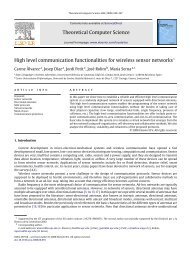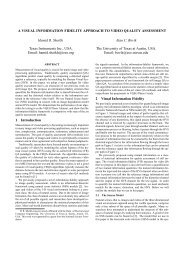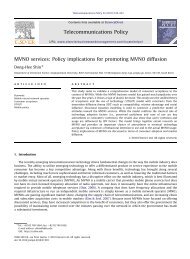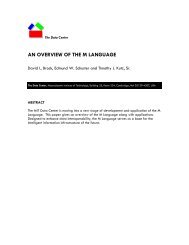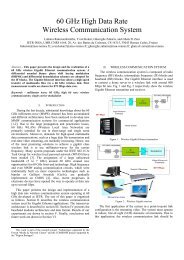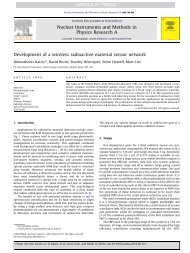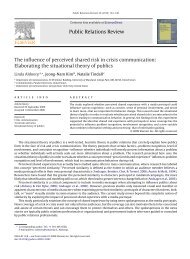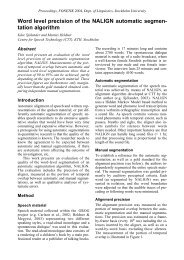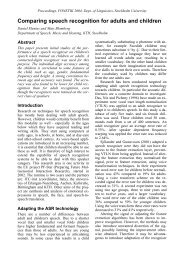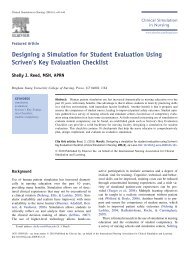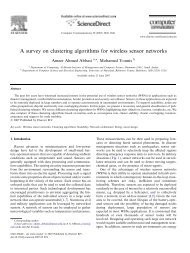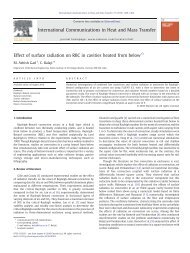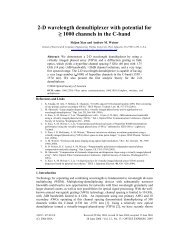BLR: beacon-less routing algorithm for mobile ad hoc networks
BLR: beacon-less routing algorithm for mobile ad hoc networks
BLR: beacon-less routing algorithm for mobile ad hoc networks
Create successful ePaper yourself
Turn your PDF publications into a flip-book with our unique Google optimized e-Paper software.
1078<br />
neverthe<strong>less</strong> interrupts sleep cycles.) The second category<br />
consists of drawbacks on the MAC- and network-layer.<br />
First, due to the periodical bro<strong>ad</strong>cast of <strong>beacon</strong>s, collisions<br />
with data packets are likely to occur. Second, the <strong>routing</strong><br />
<strong>algorithm</strong> operates on the topology as perceived through the<br />
position-in<strong>for</strong>mation provided by <strong>beacon</strong>s. However, this<br />
in<strong>for</strong>mation may be outdated or inconsistent causing the<br />
<strong>algorithm</strong>s to take suboptimal decisions. For example, a<br />
node (i.e. the <strong>routing</strong> protocol) chooses a node as next hop<br />
from its neighbor table even though this node has<br />
meanwhile left its transmission range. Even in the absence<br />
of any movement, a neighboring node may only be<br />
reachable every once a while because of time-varying<br />
transmission ranges due to changing SINR (signal to<br />
interference and noise ratio). In both cases, the MAClayer<br />
is unable to deliver the packet. Depending on the<br />
implementation, the MAC-layer tries to retransmit the<br />
packet several times after a time-out (e.g. the default value<br />
is seven times in 802.11) and only now notifies the network<br />
layer of the failed <strong>for</strong>warding. The network layer is then<br />
responsible to select another next hop. Preliminary results<br />
(not shown in this paper) obtained by simulations show that<br />
these effects cause a strong degr<strong>ad</strong>ation of the per<strong>for</strong>mance<br />
of the network in terms of delay and packet-delivery ratio.<br />
Lately, a new class of position-based <strong>routing</strong> <strong>algorithm</strong>s<br />
were introduced (<strong>BLR</strong> [37] 1 , CBF [38], IGF [39]) that avoid<br />
having <strong>beacon</strong>s transmitted periodically and, hence, eliminating<br />
the belonging drawbacks. The mechanism that<br />
allows selecting one neighbor as next hop in a completely<br />
distributed manner without having knowledge of the<br />
neighboring nodes is achieved in all the papers by applying<br />
the concept of DFD. They mainly differ in the investigated<br />
aspects. In CBF [38] and IGF [39], the focus is on the<br />
integration of the <strong>routing</strong> protocol with the MAC-layer,<br />
namely the IEEE 802.11 protocol. Heissenbüttel and Braun<br />
[37] discuss several optimizations to the basic greedy<br />
scheme and also derives analytical properties and limitations<br />
of this new class of protocols.<br />
The main drawbacks of these protocols are that greedy<br />
<strong>for</strong>warding can be applied <strong>less</strong> often than in other positionbased<br />
<strong>algorithm</strong>s due to restrictions on the position of the<br />
next node. Some <strong>ad</strong>vantages of <strong>beacon</strong>-<strong>less</strong> <strong>algorithm</strong>s are<br />
lost in case a recovery procedure needs to be initiated.<br />
There<strong>for</strong>e, these <strong>algorithm</strong>s per<strong>for</strong>m best in dense <strong>networks</strong><br />
where they operate in greedy mode most of the time.<br />
3. The <strong>BLR</strong> protocol (<strong>beacon</strong>-<strong>less</strong> <strong>routing</strong>)<br />
3.1. Assumptions<br />
Nodes are aware of their own position by means of GPS,<br />
Galileo, or any other positioning service [40]. GPS and<br />
Galileo allow nodes to determine their longitude, latitude,<br />
1 The paper is an earlier version of the present paper.<br />
M. Heissenbüttel et al. / Computer Communications 27 (2004) 1076–1086<br />
and altitude depending on the number of satellites in the<br />
line-of-sight. (For reasons of simplicity, the altitude of<br />
nodes is not considered in this paper.) Furthermore, there is<br />
a mechanism that enables the source to detect accurately<br />
enough the destination node’s position [32–34]. But,<br />
opposed to ‘conventional’ position-based <strong>routing</strong> <strong>algorithm</strong>s<br />
described in Section 2, no <strong>beacon</strong>ing mechanism is<br />
used to provide nodes with topological in<strong>for</strong>mation about<br />
their neighbors.<br />
Furthermore, there are two system-wide parameters,<br />
which are known by all the nodes. Max_delay indicates the<br />
maximum delay a packet can experience per hop, and a<br />
maximum transmission r<strong>ad</strong>ius r: The network is modeled<br />
with the unit disk graph where nodes may communicate<br />
directly if their distance is smaller than the fixed r: As a<br />
consequence, all links are bidirectional and antennas are<br />
omnidirectional.<br />
3.2. Basic principle<br />
If a source node has a data packet to send, it first<br />
determines the position of the destination and stores these<br />
geographical coordinates along with its own current<br />
position in the he<strong>ad</strong>er of the packet. All intermediate<br />
nodes just replace the previous node’s position by their<br />
current position in the he<strong>ad</strong>er be<strong>for</strong>e <strong>for</strong>warding the packet.<br />
Since a node does not possess knowledge of neighboring<br />
nodes, it bro<strong>ad</strong>casts the packet to all neighboring nodes.<br />
Upon the reception of a packet, the only available<br />
in<strong>for</strong>mation an intermediate node has is its own position<br />
and the position of the previous and the destination node,<br />
extracted from the packet he<strong>ad</strong>er. Thus, a node can easily<br />
derive if it is located within a specific area relative to the<br />
previous transmitting node.<br />
Nodes located within this <strong>for</strong>warding area apply DFD<br />
prior to relaying the packet, whereas nodes outside this<br />
area drop the received packet. The value of the DFD<br />
[0, Max_Delay ] depends on the relative position coordinates<br />
of current, previous, and destination node. Eventually,<br />
the node that computed the shortest DFD <strong>for</strong>wards the<br />
packet first. Every node in the <strong>for</strong>warding area detects the<br />
further relaying of the packet and cancels its scheduled<br />
transmission of the same packet. Furthermore, passive<br />
acknowledgments are used (cp. [41]). The previous<br />
transmitting node also detects the further relaying of the<br />
packet and thus concludes that it was successfully received<br />
by another node. Thereby, acknowledgments on the MAClayer<br />
can be avoided. (For example in IEEE 802.11, there are<br />
even no acknowledgments provided <strong>for</strong> bro<strong>ad</strong>cast packets.)<br />
The <strong>algorithm</strong> continues until the destination is reached.<br />
The only node that has to send an acknowledgement is the<br />
destination node since it does not relay the packet any<br />
further. To cope with position inaccuracies of the destination<br />
position, an <strong>ad</strong>apted and restricted reactive protocol<br />
based on AODV [2] is applied in the vicinity of the<br />
destination (Section 3.6).


